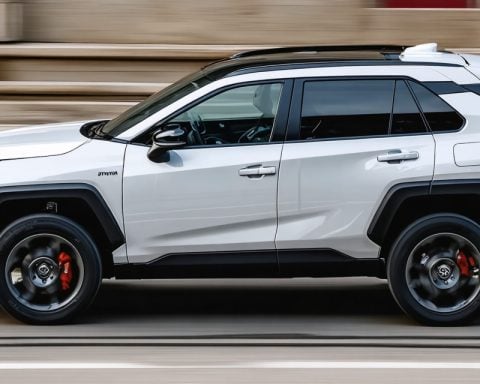How China’s Technological Shifts Signal a New Automotive Era
The horizon of China’s automotive industry is painted with bold strokes of innovation, setting a path that may redefine the global car market spectrum. The sector has witnessed a 25% surge in automotive exports, reaching an astonishing 4.8 million units in 2024, underscoring China’s dominance as the world’s top auto exporter. Even as Japan’s exports fall by 4.3% to 3.82 million units, China continues to lead the race forward.
Understanding the Forces at Play
This transformative growth is largely attributed to the rising demand for New Energy Vehicles (NEVs), which encompass electric and plug-in hybrid models. NEV exports have soared by 24.3%, hitting the 1.29 million mark. Behind this wave of success are government-backed policies designed to amplify NEV adoption through compelling subsidies and extended trade-in programs slated to last until 2025.
The Road Ahead: A Glimpse into the Future
Looking ahead, the landscape remains promising yet fraught with hurdles. The domestic scene is thriving, with a notable 5.3% rise in passenger vehicle sales and NEVs constituting nearly half of those numbers. Yet profit margins have slid to 4.4% amidst mounting price competition, leading to tighter squeezes in a burgeoning market.
Delving into the Next Gen Tech
Autonomous vehicles, cutting-edge battery tech, and advanced connectivity emerge as key arenas where China aims to assert its prowess. Investment in these areas is set to not only boost automotive exports but also seal China’s stature as a leader in tech-driven mobility solutions.
Balancing Digital Security and Sustainability
Environmental sustainability continues to be a driving theme, yet the implicit challenge lies in securing digital frameworks that vehicles rely upon. As China holds the steering wheel towards an ambitious future, balancing emission reductions with strong data security protocols becomes paramount in shaping a safe and sustainable automotive world.
With the industry’s evolution, China is poised to reshape its presence on an international scale, navigating through innovation-driven growth even amidst global economic uncertainties.
Technological Innovations in China: Steering Towards a Greener Automotive Future
China’s rapid evolution in the automotive industry, particularly through advancements in New Energy Vehicles (NEVs) and autonomous technologies, signals a significant transformation not only within its borders but also on a global scale. As the world’s leading auto exporter, China’s ambitious strides towards integrating technology and sustainability in vehicle production have far-reaching implications for the environment, humanity, and the international economy.
Environmental Impact: Paving the Way for a Cleaner Planet
The surge in New Energy Vehicle exports from China showcases a clear pivot towards more sustainable transportation options. This shift helps reduce carbon emissions significantly compared to traditional internal combustion engine vehicles. By embracing electric and hybrid models, China is not only cutting down its own environmental footprint but also influencing global markets to adopt cleaner alternatives. The government’s aggressive promotion of NEVs through subsidies and trade-in incentives until 2025 highlights an unwavering commitment to green technology, encouraging other nations to follow suit.
As the world grapples with climate change, China’s example could be a catalyst for widespread environmental reforms in the transportation sector. The proliferation of NEVs helps reduce greenhouse gas emissions and lowers pollution levels, contributing to cleaner air and healthier ecosystems across the globe.
Impact on Humanity: Reflecting on Urban Mobility and Health
On the humanitarian front, a shift towards NEVs can lead to healthier urban environments. With decreased reliance on fossil fuels and reduced emissions, the quality of air in densely populated urban centers improves significantly. This change reflects in lower rates of respiratory diseases and related health conditions, enhancing the quality of life for city dwellers. Furthermore, the promise of autonomous vehicles coupled with advanced connectivity may transform the way people commute, making travel safer and more efficient.
Economic Implications: A Double-Edged Sword
Economically, China’s focus on high-tech, sustainable automobiles positions it at the forefront of the global automotive market, potentially reshaping trade dynamics. The investment in NEV and autonomous vehicle development not only boosts China’s export numbers but also attracts international collaborations, driving innovation and economic growth. However, this rapid transformation does come with challenges, such as falling profit margins amidst competitive pricing and the need for infrastructure to support new technologies.
Connection to the Future of Humanity: What Lies Ahead
Looking towards the future, China’s technological advancements in the automotive industry may serve as a blueprint for contemporary and emergent economies alike. As the demand for cleaner, smarter, and more efficient transportation solutions grows, the integration of sustainable practices and cutting-edge technology could redefine global transportation infrastructures. Moreover, as data security and digital frameworks become more integral to modern vehicles, balancing innovation with privacy and security will be essential in garnering public trust and setting international standards.
In conclusion, China’s reshaped automotive industry is not merely a domestic triumph but a phenomenon with implications that reverberate across the world. By pioneering sustainable automotive solutions, China paves the way for a future where technology and environmental consciousness coexist, potentially driving humanity towards a more balanced and sustainable way of life. As nations continue to explore these new technology horizons, collaboration and strategic policy-making will be crucial in steering the world towards an automotive era that benefits the global community at large.
China’s Automakers Rev Up: What’s Next for the Global Car Market?
Emerging Trends in China’s Automotive Innovation
China’s automotive industry is undergoing a transformative period, marked by robust innovation that is contributing to significant global market shifts. The country’s focus on New Energy Vehicles (NEVs) has propelled it to the forefront of the automotive export race, with a 25% increase in exports to 4.8 million units in 2024. This surge has positioned China as the world’s leading auto exporter, surpassing former leader Japan, whose exports have decreased by 4.3% to 3.82 million units.
Key Innovations: From NEVs to Autonomous Driving
China’s advancements in NEVs are not just limited to increased production. The integration of cutting-edge battery technologies and continuous improvement in the fuel efficiency of electric and plug-in hybrid models have played significant roles. These advancements are further supported by government-backed policies, including substantial subsidies and trade-in programs designed to encourage NEV adoption.
Autonomous Vehicles: The Future of Mobility
In the realm of autonomous vehicles, China is channeling significant investments to push technological boundaries. The development of autonomous driving technologies is becoming a cornerstone of China’s automotive strategy, aiming to enhance safety and convenience for urban transport solutions while reducing traffic congestion and emissions.
Digital Security Meets Sustainability
As automotive technology evolves, so does the importance of digital security. China’s automotive industry is increasingly investing in secure data practices to protect connected vehicles from cyber threats. Alongside these efforts, sustainability remains a priority, with initiatives focused on reducing the carbon footprint of the manufacturing process and embracing circular economy principles.
Challenges: Profit Margins Under Pressure
Despite the promising landscape, Chinese automakers face the challenge of shrinking profit margins, which have fallen to 4.4%. This decline is fueled by intense price competition in the domestic market, as producers vie for consumers in a rapidly growing sector.
Predictions for the Future
Looking forward, China is set to maintain its trajectory as a global innovator in the automotive industry. Analysts predict continued growth in NEVs and autonomous vehicles, alongside a push for even greener technologies and expanded global market presence. This evolution suggests that China will play a crucial role in shaping the future of global car manufacturing and sales.
For more on automotive innovation and market trends, visit CNBC.
These ongoing advancements highlight the dynamic nature of China’s automotive sector, redefining global standards and contributing to a more interconnected, technologically-driven automotive future.













